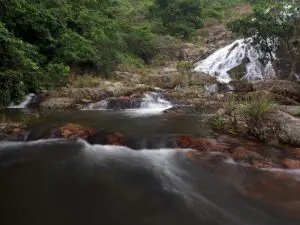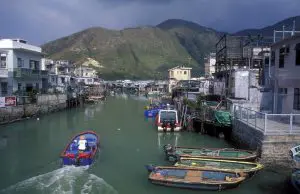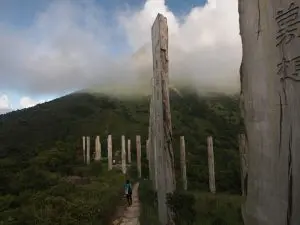There’s much to see and do on Lantau Island.
There’s much to see and do on Lantau Island. For a day-trip, you could sample one or more coastal places, maybe starting with a ferry to Mui Wo, stopping at the south coast, and finishing at Tung Chung. Here are places you can pick and choose from.
Mui Wo: Backwater with Waterfalls
Why: Mui Wo, aka Silvermine Bay was the main entry point for Lantau until the advent of Tung Chung New Town. Today, it’s something of a backwater, but well worth a visit with its beach, hamlets amidst greenery, and two splendid waterfalls.
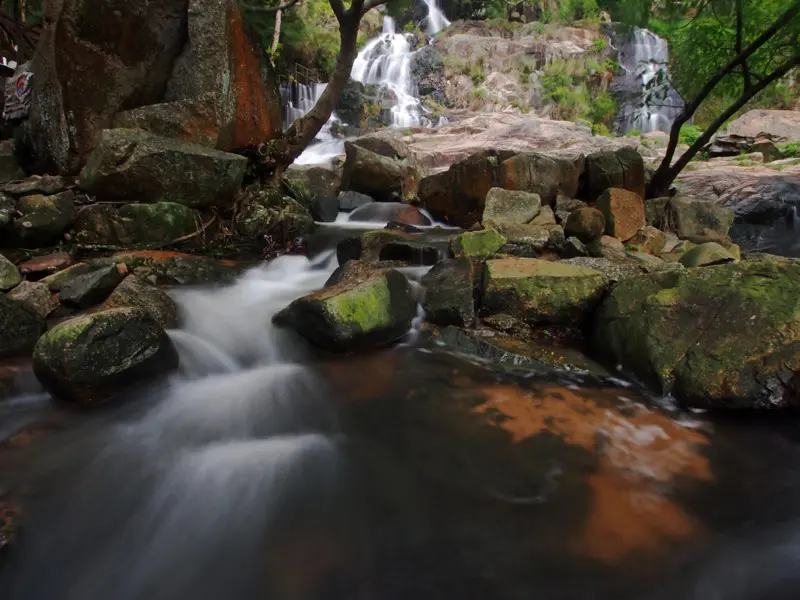
Stroll towards the beach and, just past the Silvermine Beach Resort, you can turn left to follow a route leading up and over Butterfly Hill. Nearby, the lower waterfall plunges down the foot of the hills. It’s a popular place, complete with viewing pavilion.
To find the second, “hidden” falls walk uphill, past the entrance to an abandoned silver mine. The path enters a valley, where you cross a footbridge, walk up between small farmhouses, and look for a dirt path at the base of a steep, wooded slope. Follow this and you will arrive at the upper waterfall, which cascades down a rocky slope.
In winter, there isn’t much of a flow here, but the dry conditions make rock scrambling easier, should you wish to climb the left side of the fall (take care!), to the base of a plunge pool below a short, vertical fall. This is a beautiful, tranquil corner of the world.
Getting there: Ferry from Central Pier 6; or bus 3M from Tung Chung. Instead of walking at Mui Wo, you could hire a bicycle from near the pier.
Pui O: Here Be Buffalo / How Now, Brown Cow
Why: Though the village along the main road is scruffy, Pui O boasts a fine beach, super scenery, and former paddyfields roamed by feral water buffalo.
Walk the narrow road from beside Bui O Public School, and you’ll soon find the old paddyfields to left and right. You should see buffalo here, too, maybe loitering close by the road. Though they look huge and scary, they are well used to people, intent on daily routines that mainly involve munching grass, wallowing in muddy pools and, on hot days especially, afternoon bathes in the sea.
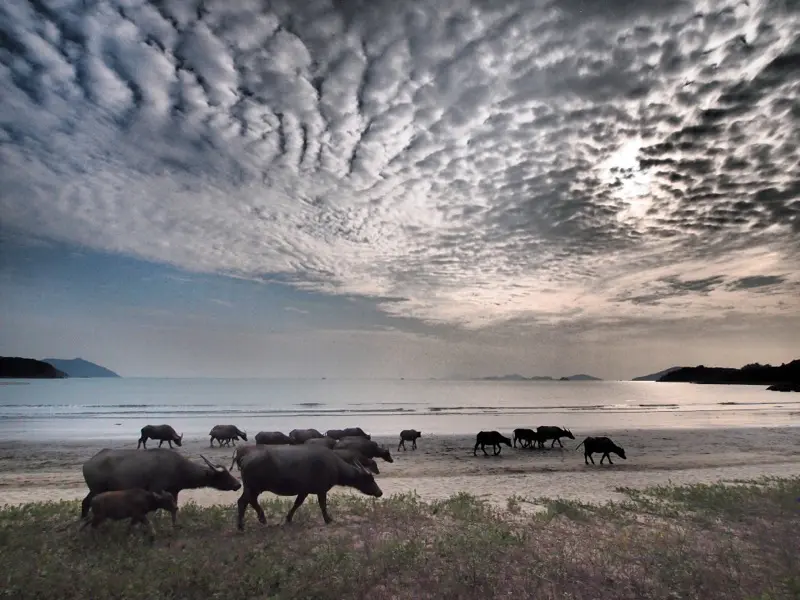
The beach of dark, fine silt is good for summer swimming; on cool days it’s best for viewing hills plunging to the south coast of Lantau. Turn right, and there’s a patch of scrub and flowers that sometimes attracts many butterflies. A concrete footpath leads through the marshy fields, back to the village.
Or turn left at the beach, and there’s a campsite that made the news when mainland tourists and Hongkongers competed for space. Perhaps Billy the cow will be hanging around, hoping for handouts.
Eastwards, beyond a stream mouth you can paddle across at low tide, a quiet road leads over hills to Shap Long. Here, too, there are buffalo fields, a stream and a beach. But few people know Shap Long, so it’s a good place if you’re concerned by cantankerous campers and wish to admire bucolic scenes of buffaloes grazing, perhaps beside trees with autumnal colours.
Getting there: All buses from Mui Wo pass through Pui O; it’s cheaper to take bus 1 (to Tai O) or 4 (to Tong Fuk); or bus 3M (to Mui Wo) from Tung Chung.
Cheung Sha: Strolling the Long Sands
Why: Cheung Sha has the best Hong Kong beach for strolling along. This is partly because, as the name meaning “Long Sands” suggests, it boasts the most extensive beach in Hong Kong, albeit there are really two beaches separated by a tiny headland. Also, there’s a relatively wild stretch, backed by greenery and facing the South China Sea.
Start at the western end, by the building with showers above a government managed strip of “gazetted beach” that can be a top option for summer swimming.
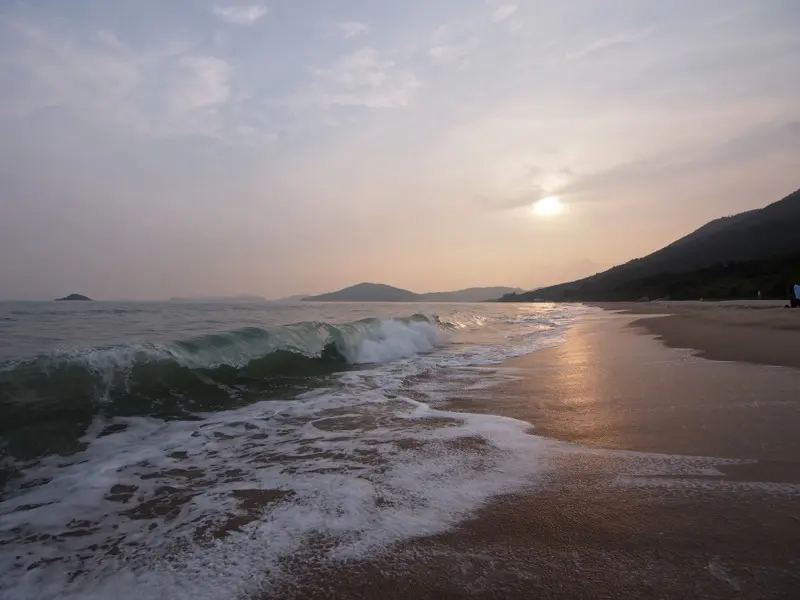
Walk east, and the road is lost from view. There are open vistas of hills, sand, sea and sky. Often, there are few people here: perhaps fishermen, sun-loving men, glamour photographers with models, and picnicking families.
There’s a watersports centre, and outdoor enthusiasts might be bodyboarding or even arrive by paragliders, after leaping from slopes far above.
Across the headland is the eastern beach, at Lower Cheung Sha. Here, too, there’s a gazetted beach, plus restaurants just above the tideline.
Getting there: Take bus 1 or 4 from Mui Wo; or bus 11 (to Tai O) from Tung Chung; buses to Ngong Ping also pass here but are a little pricier.
Shui Hau: Mudflat Marvels
Why: Set in a shallow, sheltered cove, the Shui Hau mudflats are silty rather than sticky, and teem with marine life. The receding tide exposes the flats, and you can explore in search of shellfish, hermit crabs, regular crabs, and horseshoe crabs.
The latter are “living fossils” that indeed look like they’re from a long lost era, with broad, gently curving shells hiding bodies and legs, and ending in tail spikes. Horseshoe crabs are rare in Hong Kong, and some schools rear juveniles that are released here.
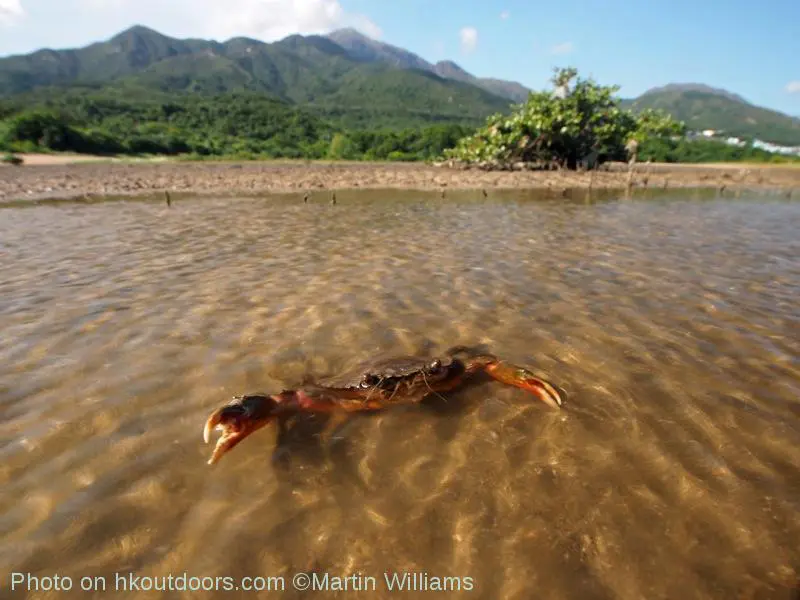
Humans may swarm the flats, digging for clams that are now smaller and scarcer due to over harvesting.
Hills including Lantau Peak serve as backdrop to the flats. Around dusk on a calm day, this can be a sublime place.
Getting there: Take bus number 1 or 4 from Mui Wo; or bus 11 from Tung Chung.
Tung Chung Bay: A Slice of Wilderness
Why: Though beside Tung Chung new town and the airport, this remains a slice of wilderness, featuring mangroves, mudflats, a historic temple and a fishing village with echoes of bygone days.
Walking from near Yat Tung Estate, you pass an old banyan complete with shrine. Further on, by the shoreline, is Hau Wong Temple. Perhaps built in 1765, this honours a general who strived to protect the last emperor of the Song dynasty from pursuing Mongol forces.
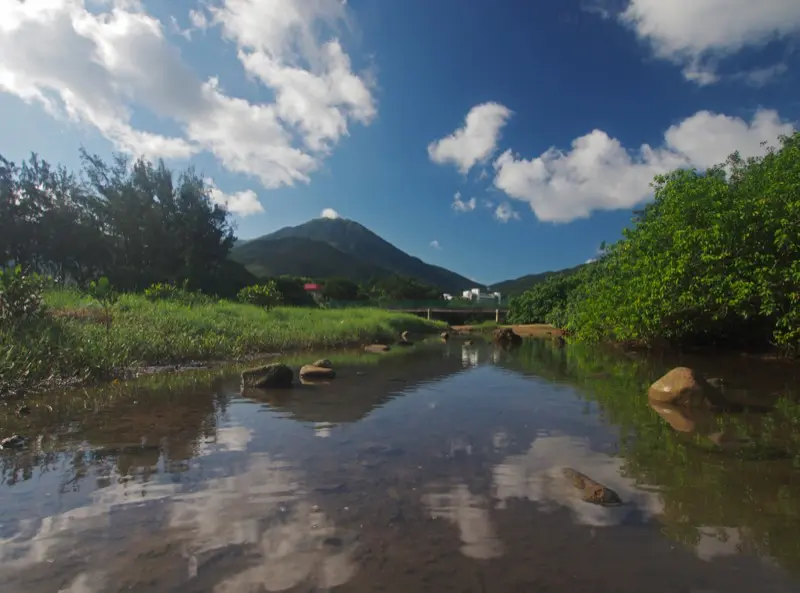
There’s a footbridge over Tung Chung Stream, where you might find kingfishers or herons. In 2004 there was considerable hoopla over villagers illegally excavating rocks from the streambed. Restoration work followed, yet now the government plans far more environmental damage here, for expansion of the new town.
Planned reclamation will also impact the bay. But for the time being, you can still enjoy the remaining natural areas.
After crossing the bridge, follow the stream channel out into the bay. Unless it’s high tide, you can head on to mudflats, which on warm days come alive with mudskippers – small, air breathing fish – and fiddler crabs waving their outsize claws. Mangrove trees are adapted to life in the tidal zone, and there are small beds of eelgrass, which is one of few flowering plants at home in the sea.
At the east of the bay is Ma Wan Chung, once the main settlement on north Lantau, now a remnant village amidst urbanisation. The small pier here is a prime site for taking sunset photos, maybe before dinner at a neighbouring restaurant.
Getting there: From southeast Lantau, take bus 3M; from southwest Lantau, bus 11. Alight as you arrive near high-rises, and cross a footbridge. Or, take the MTR or a bus to Tung Chung centre, and walk past Yat Tung Estate. To reach Ma Wan Chung from the western bay, walk north through the estate.
Written for South China Morning Post 48hrs magazine.







